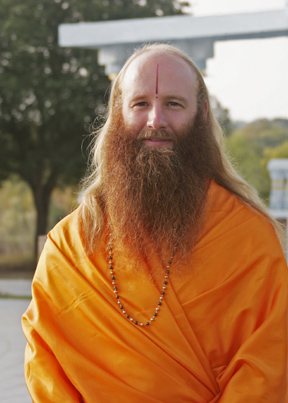
At the beginning of the fourth chapter, Shree Krishna tells Arjun that He had given this same knowledge of the Gita to Vivaswan at the beginning of the current manvantar. Hearing this, Arjun expresses surprise that Shree Krishna could have done that, because the beginning of the manvantar was over 120 million years ago, and he knows Shree Krishna to be existing right now. Then, how is it possible that Shree Krishna gave this knowledge to Vivaswan 120 million years ago?
In response, Shree Krishna explains the secret of His Divine appearance in this world (avatar rahasya). He says, “O Arjun, both you and I have had many births. I remember all of them, but you do not. Though I am unborn, immortal, and the Lord of all beings, yet, while controlling maya (the material energy), I appear in this world through My Yogmaya (Divine personal power). Whenever righteousness declines and unrighteousness increases, I manifest Myself (in My personal form) at that time.
For the protection of the pious, destruction of the wicked, and to re-establish dharm, I appear age after age. One who correctly understands that My appearance and actions are Divine does not take another birth upon leaving their body, O Arjun. Rather, they come to Me in My eternal Divine abode.” (Chapter 4, verses 5-9).
Let’s address some of the questions that may arise as a result of these statements by Shree Krishna. In the fifth verse, He states that both He and Arjun have had unlimited janm. How is this possible?
Every soul has had unlimited janm or births
As we learned in the second chapter, souls are eternal. They have existed for as long as God has existed. The third entity – maya – is also eternal. Thus, God, the souls and maya have been here forever. Maya continues to cycle through its two phases of existence – srishti (creation) and pralay (dissolution) – with the help of God. When God activates maya, then the universe is produced; and when God deactivates maya, then the universe is dissolved. Thereafter, God again activates maya, and the universe is manifested again. Thus continues the eternal cycle of srishti and pralay of the mayic universe.
Souls either exist in the state of bondage under maya, or in the state of liberation in God. Those who are under maya have been so since eternity. They are born again and again in the mayic world until they surrender to God, and with His grace become liberated.
Those souls who are under the bondage of maya continue to take rebirth in various bodies as long as the universe exists, and when the universe is dissolved, they wait in a dormant state for the next srishti. Hence, we see that all souls have had unlimited births (janm) in this mayic world, forever caught in the cycle of birth and death within the larger cycle of the birth and death of the universe.
God has also had unlimited janm
God also takes janm in this world (not only ours, but in all the other brahmands in the universe as well). He tells Arjun that just as souls have had unlimited janm, so has He had unlimited janm. This is because He repeatedly keeps taking avatar as is required to accomplish certain tasks on the earth planet, as stated in shloks seven and eight of this chapter.
The difference between God’s janm and a soul’s janm
Is there any difference between His janm and a soul’s janm? He says that for one, He remembers all of His janm and all of ours, but we don’t remember any of them. A soul’s memories of previous lifetimes are buried deep in their unconscious section of the mind; thus those memories can’t be accessed by the conscious mind of an ordinary person. So who knows what we have been and done in all of our unlimited past lives?
Not us – only God knows. And He knows all the unlimited actions of unlimited past lifetimes of unlimited souls. This is why we call Him omniscient. In contrast, we are very little knowing, because even an intelligent person would have trouble recalling what he ate for dinner last Tuesday, let alone what he did in his previous birth.
Is there any other difference between our janm and God’s janm besides the fact that He can remember all of His and all of ours, and that we can’t? In the ninth shlok, Shree Krishna states that His janm is Divine, which implies that a soul’s janm is not Divine, or is material in nature. What is a Divine janm as compared to a material janm? We will learn this in the next article.
Disciple of Jagadguru Shree Kripaluji Maharaj
Swami Nikhilanand Ji is a Canadian born Hindu spiritual leader based in Austin, Texas. He is a sanyasi disciple and pracharak of Jagadguru Shree Kripaluji Maharaj.
Attracted to the teachings of Hinduism from a young age, Swamiji eventually let his deep spiritual longing lead him to India, where he was most fortunate to come under the guidance of Shree Kripaluji Maharaj. Thereafter, living in the ashrams of JKP, he extensively studied Hindi, the philosophy of the prime Sanskrit scriptures (Vedas, Darshan Shastras, Gita, Bhagwatam), and practiced meditation in the tradition of raganuga bhakti.
In 2003, he was given sanyas. Now, with the blessings of his Guruji, he offers satsang programs throughout America, engaging audiences with his clear explanations of Hindu philosophy coupled with inspired chanting of Sanskrit mantras and shlokas and charming nam sankirtan.
His informative and compelling speeches provide practical insight into how to adopt the teachings of Sanatan Dharm into our daily lives, and inspire us to awaken our inner spiritual potential.
To stay in touch with Swami Nikhilanand Ji, like his Facebook page at https://www.facebook.com/SwamiNikhilanand or follow him on twitter at https://twitter.com/Swami_Nikhil.
Swami Nikhilanand






